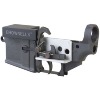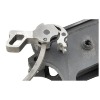BCRider
Member
I'm wondering if there's anything out there for holding pins in position that match the relationship of the pins in various actions.
The idea is to simulate the pin positions in the frame but outside where I can see any issues and gauge things and monitor progress.
I know of the trick of putting the pins through on the outside of the frame but this often results in stuff being in the way such as on a Colt style single action revolver or the pins are sloppy in the holes so the parts simply do not fit the same as they do in the gun when the pins are supported on both sides.
So I'm looking at making something that will allow me to measure and position pins of suitable size accurately centered and held rigidly vertical as they would be in the trigger group so I can work on the parts and gauge my progress more accurately.
Or do most of you that do such things simply make up a custom block for each style of gun you work with for when you need this sort of tool?
The idea is to simulate the pin positions in the frame but outside where I can see any issues and gauge things and monitor progress.
I know of the trick of putting the pins through on the outside of the frame but this often results in stuff being in the way such as on a Colt style single action revolver or the pins are sloppy in the holes so the parts simply do not fit the same as they do in the gun when the pins are supported on both sides.
So I'm looking at making something that will allow me to measure and position pins of suitable size accurately centered and held rigidly vertical as they would be in the trigger group so I can work on the parts and gauge my progress more accurately.
Or do most of you that do such things simply make up a custom block for each style of gun you work with for when you need this sort of tool?




